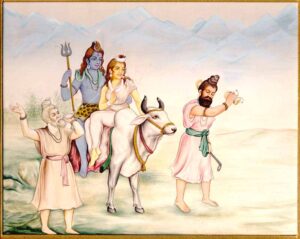We are all affected by collective karma, which has powerful trends that strongly impact us at personal and psychological levels as well as in our outer lives.
Collective karmic disturbances affect all of us. There are major collective disruptions including wars, recessions, political divisions, riots, and natural calamities like plagues, floods, droughts, earthquakes and hurricanes. In addition, technological changes in our human world can change the balance of planetary energies overall.
The particular time in which we live has its own powerful collective karmic dangers, notably 2020 with the coronavirus and extensive political, economic and religious unrest, including environmental disruptions owing to climate change. Rapid changes in the information/technology, media and education fields are also disturbing our minds and energy fields.
Collective Karma and the Vedic Birth Chart
In Vedic astrology the reading of the individual birth chart, which is what most astrologers do, may not adequately consider additional collective karmic impacts. To fully understand the trends in a person’s life Vedic astrologers usually examine the individual birth chart, planetary periods, annual charts and transits. But this may not be enough. Collective karmas are better revealed in mundane astrology, notably national charts. These extend to eclipses and major planetary alignments, which should in turn be juxtaposed relative to the specific birth chart examined.
Collective karma can easily overwhelm individual karma. When the collective karma through national or world charts is difficult then even positive indications in an individual’s birth chart may not bear fruit. I noticed in 2008, for example, a number of individual charts that were good for business gains, failed to give good results owing to the global economic collapse. The collective karma was too strong. In other words, collective karma can negate individual karma at least at an outer level.
Rahu and Ketu: The Mysterious Nodes of the Moon
The positions of the lunar nodes Rahu and Ketu are crucial in regard to collective karma. These nodes, which are involved in eclipses, are prime karmic indicators, both in the birth chart of the individual and in the mundane or world chart. In Vedic astrology, Rahu is said to be like Saturn but with a more subtle energy, and Ketu like a subtle force of Mars. In terms of society today, media influences relate more to Rahu that causes all sorts of illusions and obscurations, while technology is more Ketu based, making us more contracted in our views, particularly caught in calculations.
Having all the planets in the chart located on one side of the nodes is called Kala Sarpa Yoga in Vedic astrology, meaning the “Serpent of Time”, with Rahu as the cut off head of the serpent and Ketu as its headless body or tail. If all the planets are located between Rahu at the forward position in the zodiac and Ketu 180 degrees behind it, it is a Rahu predominant Kala Sarpa Yoga. If all the planets are between Ketu at the forward position and Rahu 180 degrees behind it, it is a Ketu predominant Kala Sarpa Yoga.
Rahu predominant Kala-Sarpa Yogas give more problems of communication and social connections, including health, environment and social disturbances, an expansive negative energy that can extent to collective forms of fear, mass and mob phobias, including epidemics. Ketu predominant Kala Sarpa Yogas give problems of values and beliefs, leading to conflict and violence, including fanaticism, a contracting negative energy.
Yet the nodes do posses a higher spiritual value, particularly Ketu which can bring a deeper insight into our lives. Ketu indicates liberation, innovation, and higher knowledge including astrology. However, accessing the higher energies of Ketu is very difficult and challenging. It is best done by individual Sadhana. Rahu can also bring karmic gains, powers of communication, karma and healing energy, but again it is difficult to hold at a collective level and may have its controversies.
2019/2020 Years of Powerful Kala Sarpa Yogas
2019 marked a very unusual Kala Sarpa Yoga that featured a retrograde conjunction of Saturn with Ketu in Sagittarius, with all the other planets behind them in the zodiac for many months This was a Ketu predominant Kala Sarpa Yoga, which involved violence, legal issues and religious conflicts.
Another Kala Sarpa Yoga is occurring now with all the planets now lined up in front of Ketu in Sagittarius in the zodiac, with Mars crossing over Ketu near the beginning of this Yoga. This is a Rahu predominant Kala Sarpa Yoga that is bringing in contagious diseases, media distortions, disruption in travel, business and communication. It will prevail from Feb. 25 to June 21, broken by the two week periods each month when the Moon is outside of the planetary Rahu-Ketu alignment. This means that the coronavirus will likely continue to be strong through the end of June, with a full recovery only later.
The current Ketu-Rahu axis between Sagittarius and Gemini is special, as it is occurring in Mula Nakshatra, near the powerful point of the galactic center astronomically, showing major karmic retribution and realignment. Mula is ruled by Ketu and reflects Ketu issues of accepting our karmic responsibility in life or facing the consequence, which can be destructive. This Sagittarius and Gemini axis involves communication and knowledge based issues as governed by Mercury and Jupiter, including media, courts and government. 2020 promises to be difficult in these respects, though for those with an awakened intelligence, higher Mercury and Jupiter energies can come in leading to inner transformation.
Other Collective Karmic Indicators
Besides Rahu and Ketu, there are many other karmic indicators and karmic factors that can be examined. This is a complicated and detailed study for advanced astrologers, which few do owing to the amount of time and effort involved, and the fact that it works best if several astrologers collaborate on the painstaking research.
Relative to interpreting the individual birth chart, a good place to begin is by examining the positions of Rahu and Ketu in the individual birth chart relative to transiting Rahu and Ketu for the year and any eclipse points involved. Each year usually features two sets of eclipses of the Sun and Moon, at intervals of about six months. Of course, there are many other factors, including the inherent strength or weakness of the birth chart, the individual’s planetary periods and transits relative to the birth charts overall. But these broader collective trends should be carefully examined as well.
So please be aware of how the collective karma is affecting your individual karma. A good Vedic astrologer can determine that for you. Vedic mundane astrology is also important, with its Panchanga and yearly Yugadi charts (Chaitrashukla Pratipad). This is based upon the New Moon in Pisces that occurs March 25 this year. We will say more about this collective karma later and its probabilities relative another article on the individuals for the Yuga chart of March 25.
Vamadeva (David Frawley)









